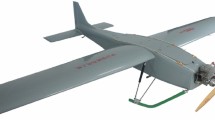Abstract
This research work examines the application of different statistical and empirical analysis methods to quantify pilot performance. A realistic approach and landing flight scenario is executed using the reconfigurable flight simulator at National Aerospace Laboratories and both subjective and quantitative measures are applied to the pilot performance data. Simulations were repeated for different difficult landing conditions like landing with degraded visibility, with crosswinds, with degraded aircraft handling qualities and with emergency conditions. Relative assessment of the different applicable metrics is made and significance of task difficulties on pilot performance is investigated. Changes in the pilot’s control strategy with respect to primary and secondary tasks are also discussed in detail. Results indicate that analysing pilot’s control strategy together with his/her deviations from predetermined flight profile provides a means to quantify pilot performance.










Similar content being viewed by others
References
Bonner M A and Wilson G F 2001 Heart rate measures of flight test and evaluation. Int. J. Aviat. Psychol. 12(1): 63–77
Petkar H, Dande S and Yadav R 2009 A pilot study to assess designer’s mental stress using eye gaze system and electroencephalogram. In: Proceedings of ASME 2009 International Design Engineering Technical Conferences and Computers and Information in Engineering Conference, 899–901
Anders G 2001 Pilot’s attention allocation during approach and landing: eye and head tracking research in am A330 full flight simulator. In: 11th International Symposium on Aviation psychology (ISAP), Columbus, OH
Biswas P and Langdon P 2015 Multimodal intelligent eye-gaze tracking system. Int. J. Human Comput. Interact. 31(4): 277–294, doi:10.1080/10447318.2014.1001301
Kramer A F 1990 Physiological metrics of mental workload: a review of recent progress. Navy Personnel Research and Development Centre
Ververs P May and Wickens C D 1998 Head up displays: effect of clutter, display intensity and display location of pilot performance. Int. J. Aviat. Psychol. 8(4): 377–403
Smith J K and Caldwell J A 2004 Methodology for evaluating the simulator flight performance of pilots. Brooks City Base, TX: Air Force Research Laboratory. Report No, AFRL-HE-BR-TR-2004-0118
Hanson C, Schaefer J, Burken J J, Larson D and Johnson M 2014 Complexity and pilot workload metrics for the evaluation of adaptive flight controls on a full scale piloted aircraft. NASA Dryden Flight Research Center; Edwards, CA United States. Document ID. 20140005730
Field E J and Giese S E D 2005 Appraisal of several pilot control activity measures. In: Proceedings of AIAA Atmospheric Flight mechanics conference and exhibit, 15–18 August 2005, San Francisco, California
Watson R W, Ntuen C and Park E 1996 Effects of task difficulty on pilot workload. In: Proceedings of the 19th International Conference on Computers and Industrial Engineering. 31(1–2): 487–490
Boeing 2014 Statistical summary of commercial jet airplane accidents (1959–2014). Washington, USA: Aviation Safety
Pashilkar A A 2014 Trends in simulation technologies for aircraft design. J. Aerosp. Sci. Technol. 22(1): 1–10
Hart S G 1986 NASA Task load Index (TLX).Volume 1.0; Paper and pencil package. Human performance research group, NASA Ames Research Centre. Document ID. 20000021488
Shepherd M J, MacDonald A, Gray W R and Cobb R G 2009 Limited simulator aircraft handling qualities evaluation of an adaptive controller. In: Proceedings of IEEE Aerospace Conference Paper 1292. doi:10.1109/AERO.2009.4839613
Ebbatson M, Huddlestone J, Harris D and Sears R 2007 The application of frequency analysis based performance measures as an adjunct to flight path derived measures of pilot performance. Hum. Factors Aerosp. Saf. 6(4): 383–394
Lampton A and Klyde D H 2012 Power frequency: a metric for analyzing pilot in the loop flying tasks. J. Guidance Control Dyn. 35(5): 1526–1537
Operations circular 9. 2011 Pilot workload, AV.22024/8/2010-FSD. Technical report, Director General of Civil Aviation
Version 05 Standards document 24 2005 Guidance to examiners: multi-pilot aeroplanes type rating skill tests and proficiency checks. Technical report. Civil Aviation Authority
FAA Advisory circular - AC120-28D. 1999. Technical report, Federal Aviation Administration
Acknowledgements
The work is carried out under a project sanctioned by Aeronautical Research and Development Board (ARDB). The authors sincerely thank the test pilot, Air Cmdr (Retd) Jose Mathappan, for supporting this study with his valuable comments and support for data collection.
Author information
Authors and Affiliations
Corresponding author
Nomenclature
Nomenclature
- δ i :
-
stick deflection
- \( \upomega_{\text{cutoff}} \) :
-
cut off frequency
- ρ:
-
level of significance
- t n :
-
flight time
- X(n):
-
Fourier coefficients of stick data
- X(m):
-
time series of stick data
- PF:
-
power frequency
- η2 :
-
effect size
Rights and permissions
About this article
Cite this article
Hebbar, P.A., Pashilkar, A.A. Pilot performance evaluation of simulated flight approach and landing manoeuvres using quantitative assessment tools. Sādhanā 42, 405–415 (2017). https://doi.org/10.1007/s12046-017-0613-0
Received:
Revised:
Accepted:
Published:
Issue Date:
DOI: https://doi.org/10.1007/s12046-017-0613-0




